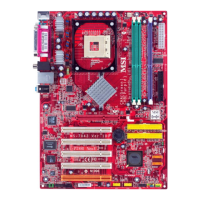B-2
MS-7043 ATX Mainboard
Introduction
This section gives a brief introduction on the RAID-related background knowledge
and a brief introduction on VIA SATA RAID Host Controller. For users wishing to install
their VIA SATA RAID driver and RAID software, proceed to Driver and RAID Software
Installation section.
RAID Basics
RAID (Redundant Array of Independent Disks) is a method of combining two or
more hard disk drives into one logical unit. The advantage of an Array is to provide
better performance or data fault tolerance. Fault tolerance is achieved through data
redundant operation, where if one drives fails, a mirrored copy of the data can be
found on another drive. This can prevent data loss if the operating system fails or
hangs. The individual disk drives in an array are called “members”. The configuration
information of each member is recorded in the “reserved sector” that identifies the
drive as a member. All disk members in a formed disk array are recognized as a single
physical drive to the operating system.
Hard disk drives can be combined together through a few different methods.
The different methods are referred to as different RAID levels. Different RAID levels
represent different performance levels, security levels and implementation costs.
The RAID levels which the VIA VT8237 SATA RAID Host Controller supports are RAID
0 and RAID 1. The table below briefly introduced these RAID levels.
RAID Level No. of Drives Capacity Benefits
RAID 0
(Striping)
2 Number drives * 2 Highest performance without data
protection
RAID 1
(Mirroring)
2 Smallest size Data protection

